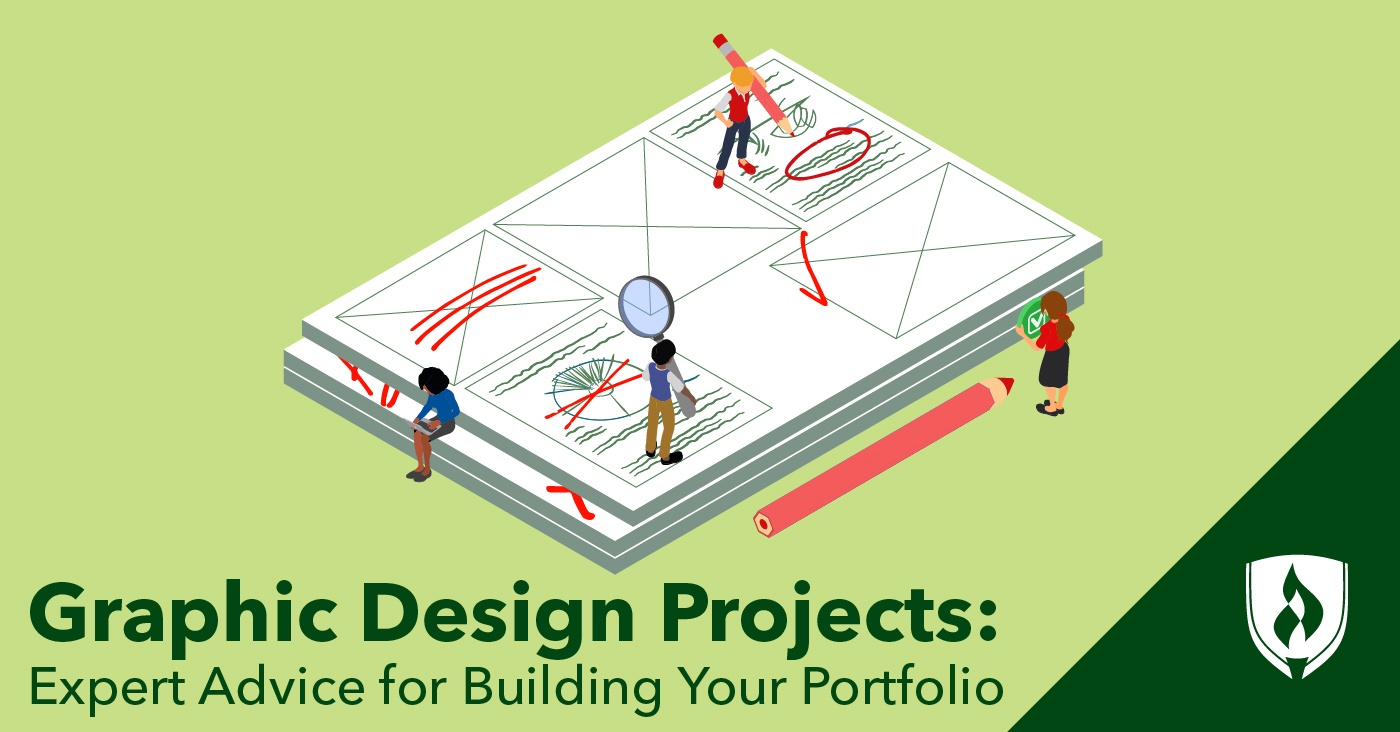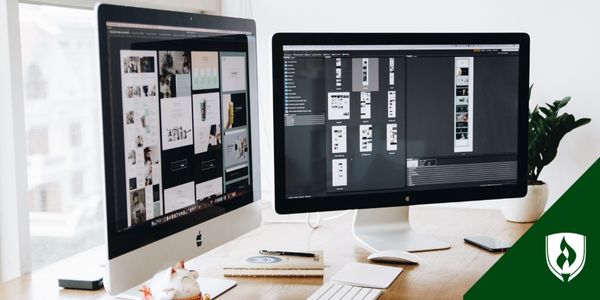
As artists and designers well know, your work often speaks louder than other elements of your resume in a creative field. Graphic design projects help you build the skills you need to thrive as a graphic designer, but finding a way to showcase those projects to help employers or prospective clients see your abilities can be daunting.
After all, you’d expect a graphic designer’s portfolio to be a work of great design in and of itself, right? For this reason, graphic designers may want to spend a little extra time and thought on their graphic design portfolio. If you are wondering about which graphic design projects employers might want to see—or what a stand-out graphic design portfolio looks like—read on! We asked graphic designers, and the professionals who hire them, to share their insights on how to make your portfolio the best possible representation of what you can do.
6 Tips for crafting your graphic design portfolio
While it’s true design is subjective and there’s no one-size-fits-all approach for building a portfolio, the following advice can still help as you work to shape your portfolio to fit the needs of your career.
1. Prioritize showcasing a few top-tier projects
Would prospective employers like to see your range and a wide sampling of skills? Sure! Does that mean you should dump all the work you’ve ever done into your portfolio? Absolutely not.
“You want to show 3 terrific pieces instead of 30 mediocre works,” says Louisa Nicholson, graphic designer and founder of Every Vegan Recipe.
“When you consider it from the audience's perspective, they don’t want to end up bored with your portfolio because it never ends,” says freelance presentation designer Adrienne Johnston. “They should think, ‘Wow, this is great work. How can I work with this designer?’”
2. Begin with your second-best piece
In the hiring process, Nicholson says potential employers and interviewers may not look over your whole portfolio before making a decision about each candidate. This means the order and pacing of your work really matters.
“You want to start your portfolio with your second best piece, then go to a piece which shows off your terrific technical skill, then go to your first best piece, and then trail off in importance from there,” Nicholson advises. This type of pace can help viewers stay engaged and increase the “wow” factor if they only look into your first few projects.
3. Try to tailor your portfolio to the position you want
“I have seen many portfolios over the years, and I can easily say that most graphic designers do not show relevancy in their portfolio,” Nicholson says. “If you're applying for a graphic design job at an agency, you want to show a variety of types of works for a variety of industries.” But if you are applying for a role in a specific industry (ex: a shoe company), Nicholson says about 75 percent of your portfolio should focus on designs relevant to that industry. Remember, that doesn’t necessarily mean you’re out of luck if you have zero designs related to shoes—you can think in terms of broader categories like designs for consumer products.
In the same way that you will have different resumes for different positions and companies, you should also have different variations of your portfolio for each audience, according to Johnston. “For instance, if you’re using your portfolio for a job application, you’re going to want to make sure that you’re showcasing an appropriate breadth and depth of skills to appeal to your prospective employer.”
But if you are using your portfolio to attract clients as a freelancer, Johnston says you will want to focus on the kind of project you love and the style that your ideal client is looking for. “After all, your portfolio is your calling card, and it’s what will attract or repel potential clients. Make sure you’re attracting the right clients.”
4. Work away from theoretical design projects
As a student, your graphic design portfolio might be entirely coursework-type pieces. While that’s understandable at the moment, Nicholson advises graphic designers to work away from theoretical designs and try to showcase more paid work. “No one wants to see how you might design something for Apple if Apple was never your client.”
Adding pieces you’ve completed for clients might mean finding internship-type opportunities or even volunteering your skills to an organization. Practically any professional graphic design work you’ve done for someone else is a step up. There’s a reason for this—real clients have real needs and professional designers need to know how to tailor their work to fit them.
5. Showcase business work
Your portfolio might feel like your own creative baby. But according to Danielle Walter, a marketing executive who hires graphic designers at Performive, a portfolio you show to potential employers needs to be designed with them in mind.
“The majority of well-paying graphic design positions are going to be for corporations,” Walter says. “I see too many portfolios full of only album covers, flyers for musicians and art-show pieces. While they are beautiful, they don’t show me how you as an artist can combine the art with critical thinking skills.”
Walter says designers who show they can infuse some new life into logo design, letterhead, business cards, brand boards, case studies, data sheet layout, google display ads or social ads will always get an interview for a corporate role. “While these may seem like they are the most boring pieces in your portfolio, to a hiring manager, they form the foundation that says you are ready to contribute a new feel to a growing brand.”
6. Treat your portfolio as a living document
“In the early days, you think that your portfolio is a deliverable that will one day be complete,” Johnston says. “The reality is graphic designers are constantly updating and tweaking their portfolios. It’s a living, breathing document.”
Just as your work experience and your graphic design skills grow, your portfolio should grow with you. “As time passes and you go to add a new project to the portfolio, you’ll see an old one and think, ‘That’s awful—I can’t believe I thought that was good.’ It’s a function of ever-increasing skills and experience,” Johnston explains. She says the best thing to do at the beginning is to pick five of your favorite projects and build the first version of a portfolio you will alter hundreds of times in your career.
Gain more experience and create more graphic design projects
It’s pretty tough to make a portfolio when you don’t have enough graphic design projects to choose from. If you are serious about earning an income in graphic design, gathering more experience and showcasing more work is vital.
And there are plenty of ways to move forward. For starters, keeping a steady flow of graphic design inspiration can help you see the possibilities for your own work. If you are a graphic design student, experts have some specific areas of advice for how you can leverage your coursework for the best portfolio impact.
But if you are finding yourself stalled by a lack of opportunity to create more work in graphic design, you might want to consider a program that will challenge your abilities and connect you to better opportunities. Learn more in our article, “Is a Graphic Design Degree Worth It or Worthless?”
Related Articles:




